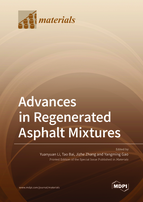Advances in Regenerated Asphalt Mixtures
A special issue of Materials (ISSN 1996-1944). This special issue belongs to the section "Construction and Building Materials".
Deadline for manuscript submissions: closed (20 January 2023) | Viewed by 18641
Special Issue Editors
Interests: novol asphalt materials; fast-repairing asphalt concretes; anti-ultraviolet aging technologies for asphalt materials; road maintenance technology
Interests: pavement; structure design; material evaluation; construction materials recycling
Special Issues, Collections and Topics in MDPI journals
Interests: the design and characterization of high-performance pavement material; the itilization of solid waste; road engineering intelligent maintenance; the intelligent detection of traffic infrastructure
Special Issues, Collections and Topics in MDPI journals
Interests: smart road materials and technologies; molecular dynamics simulations; multiscale and multiphysics modelling; fatigue damage and healing of bituminous materials
Special Issue Information
Dear Colleagues,
The recycling of asphalt mixtures has significant contributions towards the reduction in greenhouse gasses, pollution, natural resources and energy consumption. Sustainable road materials and technologies can provide a powerful boost to “carbon-neutral strategies”, and so it is crucial to continue moving forward towards improving these technologies and theories.
This Special Issue will cover new findings in the field of regenerated asphalt mixtures, including the high-content regeneration of RAP, cold recycling technologies, regenerated mechanisms, eco-regenerating agents and anti-aged materials. Additionally, novel materials, fast maintenance technologies and functional materials are also encouraged in this Special Issue, such as bio-asphalt materials, intelligent transportation, self-healing technologies, solid waste resource applications, numerical simulations, smart road materials and technologies, etc. Topics related to new experimental and theoretical studies regarding these fields are highly welcome in this Special Issue.
We are pleased to invite you to submit your research and related papers to us. As well as publishing papers, we also make papers accessible worldwide to increase their downloads and citations.
We look forward to receiving your contributions.
Dr. Yuanyuan Li
Prof. Dr. Tao Bai
Dr. Jizhe Zhang
Dr. Yangming Gao
Guest Editors
Manuscript Submission Information
Manuscripts should be submitted online at www.mdpi.com by registering and logging in to this website. Once you are registered, click here to go to the submission form. Manuscripts can be submitted until the deadline. All submissions that pass pre-check are peer-reviewed. Accepted papers will be published continuously in the journal (as soon as accepted) and will be listed together on the special issue website. Research articles, review articles as well as short communications are invited. For planned papers, a title and short abstract (about 100 words) can be sent to the Editorial Office for announcement on this website.
Submitted manuscripts should not have been published previously, nor be under consideration for publication elsewhere (except conference proceedings papers). All manuscripts are thoroughly refereed through a single-blind peer-review process. A guide for authors and other relevant information for submission of manuscripts is available on the Instructions for Authors page. Materials is an international peer-reviewed open access semimonthly journal published by MDPI.
Please visit the Instructions for Authors page before submitting a manuscript. The Article Processing Charge (APC) for publication in this open access journal is 2600 CHF (Swiss Francs). Submitted papers should be well formatted and use good English. Authors may use MDPI's English editing service prior to publication or during author revisions.
Keywords
- high-content regeneration of RAP
- cold recycling technologies
- eco-regenerating agents
- anti-aged materials
- bio-asphalt materials
- intelligent transportation
- self-healing technologies
- solid waste resource application
- numerical simulation
- smart road materials and technologies










